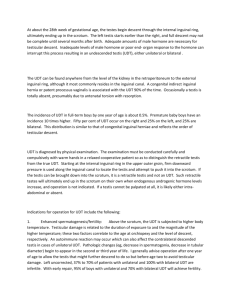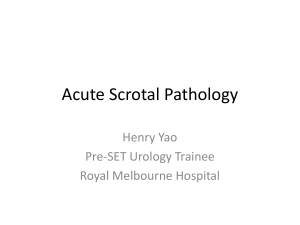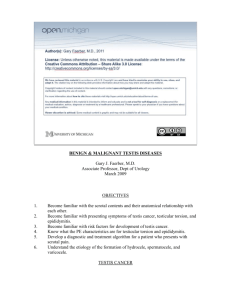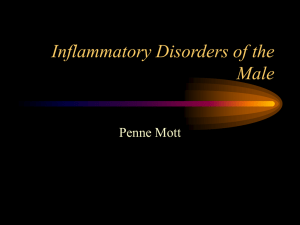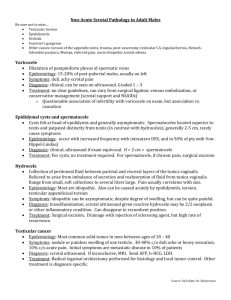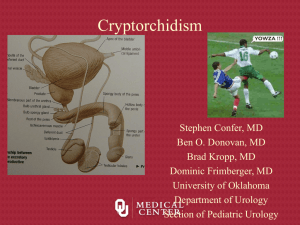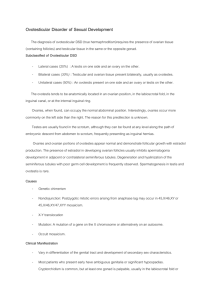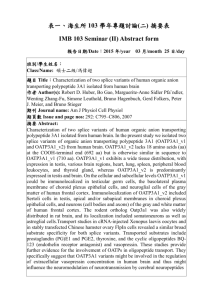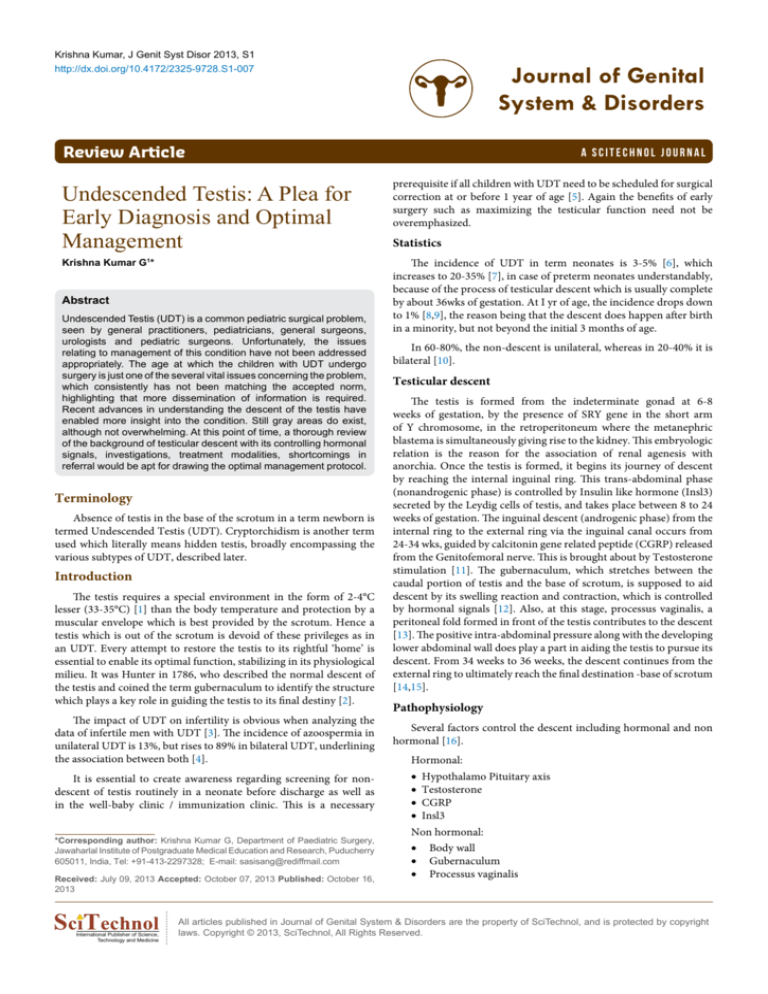
Krishna Kumar, J Genit Syst Disor 2013, S1
http://dx.doi.org/10.4172/2325-9728.S1-007
Journal of Genital
System & Disorders
Review Article
a SciTechnol journal
Undescended Testis: A Plea for
Early Diagnosis and Optimal
Management
prerequisite if all children with UDT need to be scheduled for surgical
correction at or before 1 year of age [5]. Again the benefits of early
surgery such as maximizing the testicular function need not be
overemphasized.
Krishna Kumar G *
The incidence of UDT in term neonates is 3-5% [6], which
increases to 20-35% [7], in case of preterm neonates understandably,
because of the process of testicular descent which is usually complete
by about 36wks of gestation. At I yr of age, the incidence drops down
to 1% [8,9], the reason being that the descent does happen after birth
in a minority, but not beyond the initial 3 months of age.
1
Abstract
Undescended Testis (UDT) is a common pediatric surgical problem,
seen by general practitioners, pediatricians, general surgeons,
urologists and pediatric surgeons. Unfortunately, the issues
relating to management of this condition have not been addressed
appropriately. The age at which the children with UDT undergo
surgery is just one of the several vital issues concerning the problem,
which consistently has not been matching the accepted norm,
highlighting that more dissemination of information is required.
Recent advances in understanding the descent of the testis have
enabled more insight into the condition. Still gray areas do exist,
although not overwhelming. At this point of time, a thorough review
of the background of testicular descent with its controlling hormonal
signals, investigations, treatment modalities, shortcomings in
referral would be apt for drawing the optimal management protocol.
Terminology
Absence of testis in the base of the scrotum in a term newborn is
termed Undescended Testis (UDT). Cryptorchidism is another term
used which literally means hidden testis, broadly encompassing the
various subtypes of UDT, described later.
Introduction
The testis requires a special environment in the form of 2-4°C
lesser (33-35°C) [1] than the body temperature and protection by a
muscular envelope which is best provided by the scrotum. Hence a
testis which is out of the scrotum is devoid of these privileges as in
an UDT. Every attempt to restore the testis to its rightful ‘home’ is
essential to enable its optimal function, stabilizing in its physiological
milieu. It was Hunter in 1786, who described the normal descent of
the testis and coined the term gubernaculum to identify the structure
which plays a key role in guiding the testis to its final destiny [2].
The impact of UDT on infertility is obvious when analyzing the
data of infertile men with UDT [3]. The incidence of azoospermia in
unilateral UDT is 13%, but rises to 89% in bilateral UDT, underlining
the association between both [4].
It is essential to create awareness regarding screening for nondescent of testis routinely in a neonate before discharge as well as
in the well-baby clinic / immunization clinic. This is a necessary
*Corresponding author: Krishna Kumar G, Department of Paediatric Surgery,
Jawaharlal Institute of Postgraduate Medical Education and Research, Puducherry
605011, India, Tel: +91-413-2297328; E-mail: sasisang@rediffmail.com
Received: July 09, 2013 Accepted: October 07, 2013 Published: October 16,
2013
International Publisher of Science,
Technology and Medicine
Statistics
In 60-80%, the non-descent is unilateral, whereas in 20-40% it is
bilateral [10].
Testicular descent
The testis is formed from the indeterminate gonad at 6-8
weeks of gestation, by the presence of SRY gene in the short arm
of Y chromosome, in the retroperitoneum where the metanephric
blastema is simultaneously giving rise to the kidney. This embryologic
relation is the reason for the association of renal agenesis with
anorchia. Once the testis is formed, it begins its journey of descent
by reaching the internal inguinal ring. This trans-abdominal phase
(nonandrogenic phase) is controlled by Insulin like hormone (Insl3)
secreted by the Leydig cells of testis, and takes place between 8 to 24
weeks of gestation. The inguinal descent (androgenic phase) from the
internal ring to the external ring via the inguinal canal occurs from
24-34 wks, guided by calcitonin gene related peptide (CGRP) released
from the Genitofemoral nerve. This is brought about by Testosterone
stimulation [11]. The gubernaculum, which stretches between the
caudal portion of testis and the base of scrotum, is supposed to aid
descent by its swelling reaction and contraction, which is controlled
by hormonal signals [12]. Also, at this stage, processus vaginalis, a
peritoneal fold formed in front of the testis contributes to the descent
[13]. The positive intra-abdominal pressure along with the developing
lower abdominal wall does play a part in aiding the testis to pursue its
descent. From 34 weeks to 36 weeks, the descent continues from the
external ring to ultimately reach the final destination -base of scrotum
[14,15].
Pathophysiology
Several factors control the descent including hormonal and non
hormonal [16].
Hormonal:
• Hypothalamo Pituitary axis
• Testosterone
• CGRP
• Insl3
Non hormonal:
• Body wall
• Gubernaculum
• Processus vaginalis
All articles published in Journal of Genital System & Disorders are the property of SciTechnol, and is protected by copyright
laws. Copyright © 2013, SciTechnol, All Rights Reserved.
Citation: Krishna Kumar G (2013) Undescended Testis: A Plea for Early Diagnosis and Optimal Management. J Genit Syst Disor S1.
doi:http://dx.doi.org/10.4172/2325-9728.S1-007
When the chromosome/the SRY gene is absent or mutated, the
testis does not form from the indeterminate gonad. Any disturbance
in the biosynthesis pathway for Testosterone such as deficiency/
mutational change of the enzymes would result in non production/
decreased levels of Testosterone. At the hypothalamo pituitary level,
if there is failure of GNRH release or hypopituitarism, the hormones
FSH, LH which act upon the testis become deficient leading to a
defective descent. Conditions such as Gastroschisis, Exomphalos,
Prune belly syndrome which interfere with body wall growth pose
a mechanical problem leading to non-descent. Abdominal pressure
guiding the normal descent is believed to be the mechanism. The
finding of strong association of UDT with abdominal wall defects
reiterates the same [17]. Defect in release of CGRP may account for
arrest of testis in the inguinal canal. Also, if the reciprocal reception
of molecular signals is deficient at the epididymis, non-descent would
result.
Maternal exposure to chemicals such as pesticides has been linked
with antiandrogenic effect, bringing to light various environmental
factors which could interfere with the testicular descent. It is believed
that, by their ability to cause alteration in the endocrinological
milieu and thus the signaling pathways involved, the chemicals act as
endocrine disrupters [18,19]. The proposed list of chemicals include
dioxins and furans, polychlorinated biphenyls, organochlorine
pesticides, phthalate esters, brominated flame-retardants and some
heavy metals [20].
Microscopic changes in a normal testis [21]:
• 3-6 months : neonatal gonocyte transformation to Type A
spermatogonia
• 1-3 yrs : Type A spermatogonia to Type B spermatogonia
• 3-4 yrs : Type B spermatogonia to primary spermatocyte
The neonatal gonocyte transformation to Type A spermatogonia
is a crucial step which needs to take place before 1 year of age so as to
continue future spermatogenesis [22].
In UDT which is left untreated, it has been found that by 2 yrs of
age 40% of germ cells are lost. And the normal microscopic changes
listed above get altered or do not occur to completion. As a result
the spermatogenesis is impaired to a significant extent due to the
depletion of the pool of germ cells [23].
Long term follow up studies of Orchiopexy for UDT carried out
at 9 months of age vs at 3 yrs of age, for over 4 years revealed that the
testes pexed early exhibited significantly higher testicular volumes,
supporting early surgical management [24].
When the UDT is in an abnormal location, the high temperature
prevents the transformation of gonocytes into spermatogonia and
further persistence of these may later on be the source of carcinomain- situ cells by several mutations [22]. This acts as a precursor for
testicular malignancy [25].
Overall, it is believed that it is the abnormal testis that leads to
an abnormal descent. Several studies substantiate the epididymo
testicular dysjunction, epididymal anomalies, small testicular size
[26], supporting the ‘abnormal testis - abnormal descent’ theory.
Complications of UDT
Torsion is 20% more common than a descended testis, due to
absence of normal attachments of testis. Also, the absence of the
covering by cremaster predisposes the UDT to trauma [27].
More than 90% of UDT have an accompanying inguinal hernia,
which can present with incarceration [28].
Infertility is a significant problem in bilateral UDT, as the semen
quality has been found to be poor in terms of significantly lower
sperm motility and sperm concentration [29].
The risk of developing malignancy in UDT is 3-8 times, in view of
the dysplasia in the UDT. 11% of men with testicular carcinoma have
history of UDT. It is significant to note that even the contralateral
normally descended testis also runs a small (20%) but definite
increased risk of turning malignant [30].
The relative risk of malignancy in unilateral UDT is 15 fold
whereas that in bilateral is 33 fold. The risk is also higher in an
abdominal testis than the low placed testis like the high scrotal testis
[31].
Psychological issues such as single scrotal testis, embarrassment,
concerns of sterility in an adolescent have been documented in UDT
[32].
Classification
Palpable: 80% of UDTs are palpable [33], requiring only an open
inguinal orchiopexy to ensure the scrotal environment for the testis.
The various sites can be high scrotal, canalicular, superficial inguinal
pouch, of which the commonest being the last named one.
Impalpable: 20% [33] higher the testis, greater the incidence of
dysplastic testis and abnormal spermatogenesis. Also, these would
require staged procedures/laparoscopy to complete the surgical
fixation of testis. Among the impalpable UDT, abdominal site
accounts for 45-50%, absent testis in 20-30% and atrophic testis in
30-45%.
During examination of a child with UDT, presence of a
hypertrophied contralateral descended testis favours the likelihood
of finding an atrophic/absent testis, when the UDT is not palpable.
Primary ascended testis: When the cord length is short and does
not keep up with the body growth, the testis may be ‘pulled out’ of
the scrotum resulting in an ascended position in later age. This has
been attributed variously to fibrous tethering of the cord by remnant
processus vaginalis and inadequate Testosterone surge after birth.
Of note is that this entity typically presents later in older infants and
children, unlike UDT which is identified at birth [34-36].
Vanishing testis: Due to an adverse perinatal event such as
torsion, the testis may undergo atrophy in the non-descent position,
resulting in the vanishing testis, which is evidenced by a closed
internal inguinal ring and blind ending vas/vessels on laparoscopic
examination [10,28].
Retractile testis: These are otherwise normally descended testis
but are reported absent from the scrotum by the parents. Testis can
get ejected out of the scrotum by vigorous cremasteric contraction.
This strong cremasteric reflex is believed to be the basis for retractile
testis seen commonly in children between 2-7 yrs of age. It can be
confused with UDT, but factors favouring retractile testes are the
presence of a well developed scrotum, history of testis seen sometime
in scrotum and bilateral equal sized testes. Ability to milk the testis
Genital Anomalies in Adolescents: Treatment Options that Improve Reproductive Outcomes
• Page 2 of 6 •
Citation: Krishna Kumar G (2013) Undescended Testis: A Plea for Early Diagnosis and Optimal Management. J Genit Syst Disor S1.
doi:http://dx.doi.org/10.4172/2325-9728.S1-007
down to the scrotum, on examination and make it reside in the
bottom of scrotum without immediately springing back is the best
way to confirm a retractile testis. No surgical intervention is required,
although follow up to ensure normalcy is mandatory. In view of the
possibility of late ascended testes in a small percentage of retractile
testes and high rate of confusion between UDT and retractile testes,
follow up is mandatory till puberty [37-39].
Ectopic testis: When the testis deviates from its usual path of
descent, and reaches an unusual site such as opposite scrotum, base
of penis, perineum, femoral triangle, superficial inguinal pouch the
testis is declared ectopic. What causes this deviation is explained
by different hypotheses–one of the non-scrotal gubernacular
attachments becomes dominant or the genitofemoral nerve when
placed abnormally leads to an ectopic position of the final testicular
destination [40,28]. Recommendations for orchiopexy as and when
the diagnosis is made, such as in a perineal ectopic testis, follow
the fact that ectopic location entails surgical correction always. At
surgery, the cord length is usually longer permitting a comfortable
pexy in scrotum, unlike the case of the intra-abdominal testis [41].
Management
Clinical examination
Before proceeding onto decide the management in UDT, it is
essential to perform a thorough examination. Observation of scrotal
symmetry and development, opposite testicular size and position,
penile size all form part of the clinical assessment. During examination,
the position of the child is vital as cremasteric contraction can destabilize the testis. In an older child who would be able to squat or sit
cross legged, testicular position can be reliably evaluated, eliminating
the cremasteric reflex which can interfere with the examination. In a
neonate or infant, the technique consists of warming the hand prior
to examination, gentle but firm milking from the top of groin near
the anterior superior iliac spine down to the pubic tubercle, ensuring
palpation of a high placed UDT [42].
Investigations
For the pre-operative work up, Hb, urine examination may be
required. The combination of UDT with hypospadias, especially the
proximal variety (proximal penile, penoscrotal, scrotal hypospadias)
should alert to the possibility of disorders of sexual differentiation
or ambiguous genitalia. Role of endocrinological evaluation in the
form of LH, FSH, Testosterone levels is pertinent in bilateral UDT to
identify the etiology.
Sonographic imaging cannot reliably identify an UDT and
furthermore inter observer variation can falsely identify inguinal
nodes as testis. Utility of sonography is limited in UDT except in
instances such as obesity (where clinical examination may be noncontributory), ambiguous genitalia (to identify mullerian structures)
[43]. Baskin et al. in a recent review on diagnostic modalities in UDT
concluded that routine ultrasound has no role in cryptorchidism [44].
Hormonal therapy
Uses of HCG, GNRH analogues have not achieved a consensus
agreement in the management of UDT. Documentation of adverse
effects of hormones on gonadal histology has brought caution on
the usage of hormonal therapy in UDT. Conflicting reports on their
usage in retractile, scrotal l bilateral testis has generally discouraged
the routine use of hormonal therapy in UDT [5,47].
Surgery
Examination under anesthesia (EUA) is an important maneuver
not only in deciding whether testis is palpable or not, but also in
deciding whether an additional procedure such as laparoscopy is
required in the event of a non-palpable testis. In scenarios such as
chubby child, crying/difficult to examine the decision of only an
orchiopexy or laparoscopy and proceed, has to be reserved until
EUA is performed, to make a confident decision on the surgical
management.
When the UDT is palpable, the surgical technique involves an
open inguinal approach. The essential steps of open orchiopexy
include ligation of processus vaginalis, lengthening the cord/
skeletonizing the vas and vessels to release fibrous bands, scrotal
tunneling and fixation in the extra dartos pouch. When the testis is
pexed in the extra dartos pouch, care is taken to avoid passing suture
through the parenchyma of testis, which may breach the blood-testis
barrier and induce antibody formation later on [42].
Scrotal approach instead of an inguinal approach has been
advocated in cases where the UDT is palpable and can be manipulated
by examination to reach the upper scrotum. The scrotal fixation
technique has the added advantage of improved cosmesis with no
groin scar, but cannot be used in UDT where the testis is high and
cannot be milked down to the root of scrotum [48,49].
Laparoscopy is of use in impalpable testis to identify the location
of testis as well as to perform procedures to bring down the testis,
serving the dual function of diagnostic cum therapeutic modality
[50]. Its ability to perform successful orchiopexy in as much as
96% of impalpable UDT has made it as an indispensable tool in the
management of UDT [46,51]. The likely possibilities on laparoscopy
for an impalpable testis are
i. intra-abdominal testis 50%,
ii. Vas / vessels exiting internal ring 5-10%
iii. Blind ending vas 40-45% [52,53].
In instances where the length of the vessels is short, which
is always the deciding factor in case of intra-abdominal testis,
procedures such as Stephen-Fowler and microvascular repair can be
used. The Stephen-Fowler technique involves reliance of testicular
blood supply by collaterals from vasal and cremasteric arteries, when
the testicular artery is ligated [54].
Long term outcome
Studies point out the limited utility of other modalities such as
MR, Angiography. MRI has low sensitivity in identifying atrophic
and intra-abdominal testes but is better at locating inguino-scrotal
testes [45].
In unilateral UDT, after orchiopexy, the fertility rates do not
significantly differ from the general population. The paternity rates
range from 70-90%, as per various studies [55].
Laparoscopy has been accepted as the gold standard investigation
cum therapeutic modality in impalpable testis [46].
In bilateral UDT, the paternity rates are between 25-60%,
underlining the high possibility of abnormal testes with altered
Genital Anomalies in Adolescents: Treatment Options that Improve Reproductive Outcomes
• Page 3 of 6 •
Citation: Krishna Kumar G (2013) Undescended Testis: A Plea for Early Diagnosis and Optimal Management. J Genit Syst Disor S1.
doi:http://dx.doi.org/10.4172/2325-9728.S1-007
spermatogenesis. The infertility rate is 6 times higher in men with
bilateral UDT, in comparison with unilateral UDT men [56].
Testicular tumours associated with UDT become manifest by the
age of 20-40 years and are mostly seminomas [57]. Also, there is an
increased risk of malignancy in the normally descended contralateral
testis in an individual with unilateral UDT [58].
In those with UDT where the testis was removed or absent at
surgical exploration, the empty scrotum had a traumatic psychological
impact in these individuals [59]. It is essential to offer implantation of
testicular prosthesis in such cases, which has shown improvement in
self-esteem and body image [60].
Need for early intervention
In view of the fact that
I.
Testes do not descend after 6 months of age [61-63].
II.
Improvement in semen analysis (sperm counts and motility)
when operated before 1 year of age [64].
III.
Testicular volume increases considerably when procedure is
undertaken before 3 years of age [24].
IV.
Malignancy rates are lower in children operated before 13
years of age [65].
V.
Longer the testis remain in undescended location, poorer is
the growth after orchiopexy [66].
VI.
Atrophy of the seminiferous tubules to the tune of 90% by 2
years of UDT [26].
Early surgery for UDT is essential to fully utilize the potential of
the testis and to avoid complications of untreated UDT or delayed
surgery for UDT [67]. It is agreed that in a centre with support
facilities for an infant, surgery can be undertaken before 1 year of
age [5].
Screening for UDT
For management of UDT, screening is a valuable tool for
identification and appropriate referral. The focus is not only directed
to the neonates but also children at 8-9 months of age and those at
39-42 months of age, as the pickup rate of missed UDT and primary
ascended testes can be improved [68]. Late referrals of UDT form a
good majority of those children undergoing surgery for UDT well
beyond the recommended age for orchiopexy [69,70]. Also, this may
not only reflect the accuracy of the neonatal examination technique,
but also of difficulty in distinguishing from retractile testes. By ways
of dissemination of information on UDT, it is indeed possible to
circumvent the problems of delayed referral by appropriate education
[71]. The best practice point is that referral of the child in whom the
testicular position cannot be ascertained reliably, is to be undertaken
in the infancy rather than waiting till the child grows up [72].
Conclusion
Screening for UDT at birth before a child is discharged is an
important step towards early detection. Well baby clinics providing
vaccination services should screen babies between 0-6 months of age.
School health checks and awareness of GP/Paediatricians/Nurses
also form essential strategies. Age accepted currently for Orchiopexy
as 6-12 months of age is another vital fact which requires wide
dissemination to favour optimal management of UDT. Orchiopexy
is an essential step towards prevention of torsion and subsequent
testicular loss. Orchiopexy does not eliminate the risk of malignancy
in an UDT, but rather helps in later testicular examination.
References
1. Thonneau P, Bujan L, Multigner L, Mieusset R (1998) Occupational heat
exposure and male fertility: a review. Hum Reprod 13: 2122-2125.
2. Hunter J (1762) Observations on the state of the testis in the fetus, and on
the hernia congenita. Hunter W (ed.), William Hunter Medical Commentaries.
London: Hamilton 1762:75–90.
3. Chung E, Brock GB (2011) Cryptorchidism and its impact on male fertility: a
state of art review of current literature. Can Urol Assoc J 5: 210-214.
4. Hadziselimovic F, Herzog B (2001) The importance of both an early
orchidopexy and germ cell maturation for fertility. Lancet 358: 1156-1157.
5. Ritzen EM (2008) Undescended testes: a consensus on management. Eur J
Endocrinol 159 Suppl 1: S87-S90.
6. Thong M, Lim C, Fatimah H (1998) Undescended testes: incidence in 1,002
consecutive male infants and outcome at 1 year of age. Pediatr Surg Int 13:
37-41
7. Scorer CG (1985) The anatomy of testicular descent normal and incomplete.
Brit Med J 27: 374-378.
8. Scorer CG (1956) The incidence of incomplete descent of the testicle at birth.
Arch Dis Child 31: 198-202.
9. (1992) Cryptorchidism: a prospective study of 7500 consecutive male births,
1984-8. John Radcliffe Hospital Cryptorchidism Study Group. Arch Dis Child
67: 892-899.
10.Nassar AH (1995) Laparoscopic-assisted orchidopexy: a new approach to
the impalpable testis. J Pediatr Surg 30: 39-41.
11.Nation TR, Balic A, Southwell BR, Newgreen DF, Hutson JM (2009) The
hormonal control of testicular descent. Pediatr Endocrinol Rev 7: 22-31.
12.Hutson JM, Hasthorpe S (2005) Testicular descent and cryptorchidism: the
state of the art in 2004. J Pediatr Surg 40: 297-302.
13.Tanyel FC (2004) Obliteration of processus vaginalis: aberrations in the
regulatory mechanism result in an inguinal hernia, hydrocele or undescended
testis. Turk J Pediatr 46: 18-27.
14.
Virtanen HE, Toppari J (2008) Epidemiology and pathogenesis of
cryptorchidism. Hum Reprod Update 14: 49-58.
15.Hutson JM, Sasaki Y, Huynh J, Yong E, Ting A (2004) The gubernaculum in
testicular descent and cryptorchidism. Turk J Pediatr 46: 3-6.
16.Hughes IA, Acerini CL (2008) Factors controlling testis descent. Eur J
Endocrinol 1: S75-82.
17.Yardley IE, Bostock E, Jones MO, Turnock RR, Corbett HJ, et al. (2012)
Congenital abdominal wall defects and testicular maldescent--a 10-year
single-center experience. J Pediatr Surg 47: 1118-1122.
18.McGlynn KA, Guo X, Graubard BI, Brock JW, Klebanoff MA, et al. (2009)
Maternal pregnancy levels of polychlorinated biphenyls and risk of
hypospadias and cryptorchidism in male offspring. Environ Health Perspect
117: 1472-1476.
19.Kurahashi N, Kasai S, Saijo Y, Sata F, Kishi R (2005) Exposure to endocrine
disrupting chemicals and human health: a review of epidemiological studies
focused on hypospadias and cryptorchidism. Nihon Eiseigaku Zasshi 60: 1522.
20.Carbone P, Giordano F, Nori F, Mantovani A, Taruscio D, et al. (2007)
The possible role of endocrine disrupting chemicals in the aetiology of
cryptorchidism and hypospadias: a population-based case-control study in
rural Sicily. Int J Androl 30: 3-13.
21.
Hadziselimovic F, Huff D (2002) Gonadal differentiation--normal and
abnormal testicular development. Adv Exp Med Biol 511: 15-21.
22.Ong C, Hasthorpe S, Hutson JM (2005) Germ cell development in the
descended and cryptorchid testis and the effects of hormonal manipulation.
Pediatr Surg Int 21: 240-254.
Genital Anomalies in Adolescents: Treatment Options that Improve Reproductive Outcomes
• Page 4 of 6 •
Citation: Krishna Kumar G (2013) Undescended Testis: A Plea for Early Diagnosis and Optimal Management. J Genit Syst Disor S1.
doi:http://dx.doi.org/10.4172/2325-9728.S1-007
23.Eisendrath DN (1916) Undescended Testis. Ann Surg 64: 324-328.
luteinising-hormone-releasing-hormone nasal
undescended testes. Lancet 1: 876-880.
spray
in
treatment
of
24.Kollin C, Hesser U, Ritzen EM, Karpe B (2006) Testicular growth from birth
to two years of age, and the effect of orchidopexy at age nine months: a
randomized, controlled study. Acta Paediatr 95: 318-324.
48.Bianchi A, Squire B (1989) Trans scrotal Orchidopexy: Orchidopexy revised.
Pediatr Surg Int 4: 189-92.
25.Hoei-Hansen CE, Rajpert-De Meyts E, Daugaard G, Skakkebaek NE (2005)
Carcinoma in situ testis, the progenitor of testicular germ cell tumours: a
clinical review. Ann Oncol 16: 863-868.
49.Bassel YS, Scherz HC, Kirsch AJ (2007) Scrotal incision orchiopexy for
undescended testes with or without a patent processus vaginalis. J Urol 177:
1516-1518.
26.Tasian GE, Hittelman AB, Kim GE, DiSandro MJ, Baskin LS (2009) Age at
orchiopexy and testis palpability predict germ and Leydig cell loss: clinical
predictors of adverse histological features of cryptorchidism. J Urol 182: 704709.
50.Williams EV, Appanna T, Foster ME (2001) Management of the impalpable
testis: a six year review together with a national experience. Postgrad Med J
77: 320-322.
27.Singal AK, Jain V, Dubey M, Deshpande P (2013) Undescended testis and
torsion: is the risk understated? Arch Dis Child 98: 77-79.
51.Papparella A, Romano M, Noviello C, Cobellis G, Nino F, et al. (2010) The
value of laparoscopy in the management of non-palpable testis. J Pediatr Urol
6: 550-554.
28.Hutson JM (2006) Undescended testis, torsion, and varicocele. Gross feld
JL, O’Neil JAJ, Fonkalsrud EW, Coran AG (eds.) Pediatric Surgery (6thedn.)
Philadelphia: Mosby 1193-214.
52.Diamond DA, Caldamone AA (1992) The value of laparoscopy for 106
impalpable testes relative to clinical presentation. J Urol 148: 632-634.
29.Lee PA, Coughlin MT (2001) Fertility after bilateral cryptorchidism. Evaluation
by paternity, hormone, and semen data. Horm Res 55: 28-32.
53.Moore RG, Peters CA, Bauer SB, Mandell J, Retik AB (1994) Laparoscopic
evaluation of the nonpalpable tests: a prospective assessment of accuracy. J
Urol 151: 728-731.
30.Martin DC (1982) Malignancy in the cryptorchid testis. Urol Clin North Am 9:
371-376.
54.Bloom DA (1991) Two-step orchiopexy with pelviscopic clip ligation of the
spermatic vessels. J Urol 145: 1030-1033.
31.Dieckmann KP, Pichlmeier U (2004) Clinical epidemiology of testicular germ
cell tumors. World J Urol 22: 2-14.
55.Miller KD, Coughlin MT, Lee PA (2001) Fertility after unilateral cryptorchidism.
Paternity, time to conception, pretreatment testicular location and size,
hormone and sperm parameters. Horm Res 55: 249-253.
32.Bell AI (1974) Psychologic implications of scrotal sac and testes for the male
child. Clin Pediatr (Phila) 13: 838-843, 846-847.
33.Spencer JR (1994) The endocrinology of testicular descent. AUA Update
Series Lesson 12: 94-99.
56.Lee PA (1993) Fertility in cryptorchidism. Does treatment make a difference?
Endocrinol Metab Clin North Am 22: 479-490.
34.Taghizadeh AK, Thomas DF (2008) Ascent of the testis revisited: fact not
fiction. BJU Int 102: 676-678.
57.Giwercman A, Grindsted J, Hansen B, Jensen OM, Skakkebaek NE (1987)
Testicular cancer risk in boys with maldescended testis: a cohort study. J Urol
138: 1214-1216.
35.
Clarnette TD, Rowe D, Hasthorpe S, Hutson JM (1997) Incomplete
disappearance of the processus vaginalis as a cause of ascending testis. J
Urol 157: 1889-1891.
58.Akre O, Pettersson A, Richiardi L (2009) Risk of contralateral testicular
cancer among men with unilaterally undescended testis: a meta analysis. Int
J Cancer 124: 687-689.
36.Acerini CL, Miles HL, Dunger DB, Ong KK, Hughes IA (2009) The descriptive
epidemiology of congenital and acquired cryptorchidism in a UK infant cohort.
Arch Dis Child 94: 868-872.
59.Money J, Sollod R (1978) Body image, plastic surgery (prosthetic testes) and
Kallmann’s syndrome. Br J Med Psychol 51: 91-94.
37.Hack WW, Sijstermans K, van Dijk J, van der Voort-Doedens LM, de Kok ME,
et al. (2007) Prevalence of acquired undescended testis in 6-year, 9-year and
13-year-old Dutch schoolboys. Arch Dis Child 92: 17-20.
38.Hack WW, Meijer RW, Van Der Voort-Doedens LM, Bos SD, De Kok ME
(2003) Previous testicular position in boys referred for an undescended testis:
further explanation of the late orchidopexy enigma? BJU Int 92: 293-296.
39.McCabe JE, Kenny SE (2008) Orchidopexy for undescended testis in
England: is it evidence based? J Pediatr Surg 43: 353-357.
40.Lockwood CB (1888) Development and Transition of the Testis,Normal and
Abnormal. J Anat Physiol 22: 505-41.
60.Turek PJ, Master VA, Testicular Prosthesis Study Group (2004) Safety and
effectiveness of a new saline filled testicular prosthesis. J Urol 172: 14271430.
61.Kolon TF, Patel RP, Huff DS (2004) Cryptorchidism: diagnosis, treatment,
and long-term prognosis. Urol Clin North Am 31: 469-480.
62.Berkowitz GS, Lapinski RH, Dolgin SE, Gazella JG, Bodian CA, et al. (1993)
Prevalence and natural history of cryptorchidism. Pediatrics 92: 44-49.
63.Taskinen S, Hovatta O, Wikstrom S (1997) Sexual development in patients
treated for cryptorchidism. Scand J Urol Nephrol 31: 361-364.
41.Celayir AC, Sander S, Eliçevik M (2001) Timing of surgery in perineal ectopic
testes: analysis of 16 cases. Pediatr Surg Int 17: 167-168.
64.Canavese F, Mussa A, Manenti M, Cortese MG, Ferrero L, et al. (2009)
Sperm count of young men surgically treated for cryptorchidism in the first
and second year of life: fertility is better in children treated at a younger age.
Eur J Pediatr Surg 19: 388-391.
42.Hutson JM (2008) Undescended testis and varicocele. Hutson JM, O’Brien
M, Woodward AA, and Beasley SW (eds.) Jones’ Clinical Paediatric Surgery:
Diagnosis and Management (6thedn.) Oxford, Blackwell Publishing, UK.
65.Pettersson A, Richiardi L, Nordenskjold A, Kaijser M, Akre O (2007) Age at
surgery for undescended testis and risk of testicular cancer. N Engl J Med
356: 1835-1841.
43.Elder JS (2002) Ultrasonography is unnecessary in evaluating boys with a
nonpalpable testis. Pediatrics 110: 748-51.
66.Kollin C, Granholm T, Nordenskjold A, Ritzen EM (2013) Growth of
spontaneously descended and surgically treated testes during early
childhood. Pediatrics 131: e1174-e1180.
44.Tasian GE, Copp HL (2011) Diagnostic performance of ultrasound in
nonpalpable cryptorchidism: a systematic review and meta-analysis.
Pediatrics 127: 119-128.
45.Krishnaswami S, Fonnesbeck C, Penson D, McPheeters ML (2013) Magnetic
resonance imaging for locating nonpalpable undescended testicles: a metaanalysis. Pediatrics 131: e1908-e1916.
67.Rey RA (2012) Early orchiopexy to prevent germ cell loss during infancy in
congenital cryptorchidism. J Clin Endocrinol Metab 97: 4358-4361.
68.Neilson AG, Walker GM (2011) Screening of testicular descent in older boys
is worthwhile: an observational study. Br J Gen Pract 61: 173-177.
46.Chang B, Palmer LS, Franco I (2001) Laparoscopic orchidopexy: a review of
a large clinical series. BJU Int 87: 490-493.
69.Steckler RE, Zaontz MR, Skoog SJ, Rushton HG (1995) Cryptorchidism,
pediatricians, and family practitioners: patterns of practice and referral. J
Pediatr 127: 948-951.
47.deMuinck Keizer-Schrama S, Hazebroek FW, Matroos AW, Drop SL,
Molenaar JC, et al. (1986) Double-blind, placebo-controlled study of
70.Upadhyay V, Kothari M, Manoharan M (2001) The referral pattern for
undescended testes in Auckland. N Z Med J 114: 310-311.
Genital Anomalies in Adolescents: Treatment Options that Improve Reproductive Outcomes
• Page 5 of 6 •
Citation: Krishna Kumar G (2013) Undescended Testis: A Plea for Early Diagnosis and Optimal Management. J Genit Syst Disor S1.
doi:http://dx.doi.org/10.4172/2325-9728.S1-007
71.Brown JJ, Wacogne I, Fleckney S, Jones L, Ni Bhrolchain C (2004) Achieving
early surgery for undescended testes: quality improvement through a
multifaceted approach to guideline implementation. Child Care Health Dev
30: 97-102.
72.Snodgrass W, Bush N, Holzer M, Zhang S (2011) Current referral patterns
and means to improve accuracy in diagnosis of undescended testis.
Pediatrics 127: e382-e388.
Author Affiliations
Top
Department of Paediatric Surgery, Jawaharlal Institute of Postgraduate
Medical Education and Research, Puducherry, India
1
Submit your next manuscript and get advantages of SciTechnol
submissions
This article is published in the special issue “Genital Anomalies
in Adolescents: Treatment Options that Improve Reproductive
Outcomes” and has been edited by Dr. Lawrence S. Amesse, Wright
State University Boonshoft School of Medicine, USA
Genital Anomalies in Adolescents: Treatment Options that Improve Reproductive Outcomes
50 Journals
21 Day rapid review process
1000 Editorial team
2 Million readers
More than 5000
Publication immediately after acceptance
Quality and quick editorial, review processing
Submit your next manuscript at ● www.scitechnol.com/submission
• Page 6 of 6 •

